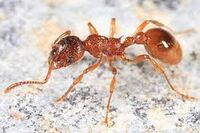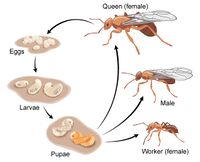European Fire Ant

Description
Belonging to the large order Hymenoptera, myrmica rubra are a widespread ant species commonly known as the "fire ant" or "red ant" due to their light reddish-brown coloring. The species is known for its aggressive nature and the threat it poses against both humans and animals. Viewed as a nuisance, they are often treated with pesticides and eradicated from areas of high population. [3]
Habitat
Native to Europe, the ant species is found in temperate or wet regions, often in areas disturbed by humans. reside in meadows, forests, and various grassy or disturbed lands. They nest in rotting wood or bark, tufts of grass or can be found in the soil or under rocks when in regions of high precipitation where rainwater is stored in the ground. They are also commonly found in vegetation along rivers. And when on non-native lands they prefer regions like moist, open meadows at high altitudes that mimic their homeland of Western Europe.
Located on 5 continents, it is one of the most widespread ant species within the Myrmicinae subfamily due to it's ability to easily adapt its physiology and behavior to suit its environment. It's range spans from Portugal to Siberia and from Northern Greece to the Forest-Tundra. Ants are commonly spread by human activity causing the species to be invasive in many regions including North America. [1]
Anatomy

Like most insects, Fire Ants' bodies are divided into three sections - the Head, Thorax and Abdomen. They also have an exoskeleton - made of chitin[4] that provides an area for the attachment of muscles and serves as a protective casing around the body.[5]
Head
The Head consists of the ant's eyes, mandibles, and a pair of elbowed or bent antennae. Fire ants have poor eye-sight and instead rely on their antennae to find food, sense their surroundings and communicate with other ants [5]. The mandibles act as arms; being able to hold and carry objects, cut, dig, and fight. They can also be used as a set of teeth, able to bite and chew food [6]. And while ants do chew their food, they are unable to digest solids and instead suck the liquid from their prey.
Thorax
The Thorax is the center section of the ant's body with 3 pairs of legs attached. While most ants do not have wings, "reproductives" do. Reproductives are produced in order for them to fly to another area and begin a nest of their own.
Abdomen
The Abdomen, also known as Gaster, is the rear section of the ant's body and contains the digestive organs and stinger. The Thorax and Abdomen are connected together by 2 extensions of the abdomen called petioles [5]. It also contains an acidopore which stores the formic acid that is injected into prey when stung. This acid is what causes a painful reaction when stung, while no noticable pain is caused by a bite [4].
Diet & Behavior
Diet
Behavior
European Fire Ants live in colonies made up of thousands of individual ants, each with their own role. An Ant's role is determined by their size:
Queens are the largest ants in the colony. They will lay eggs throughout their entire life, sometimes up to 1,000 per day and can live up to 7 years [8].
Workers are smaller females. They will not reproduce but instead perform other jobs such as gathering food, caring for the young and cleaning. Those with the largest heads in this group are tasked with protecting the colony. These protector ants are known for their aggression and will not hesitate to emerge from the nest and sting if provoked. They have a lifespan of several months.
Males are winged ants that mate with the Queen. They will live for a few weeks and their sole purpose is to mate during this time [7].
Life Cycle

Fire Ants go through 4 life stages, undergoing complete metamorphosis. They are laid as eggs, small ovals the size of the tip of a pen. Then the eggs hatch into larvae. Larvae eat continuously causing them to grow rapidly and molt as they become larger [7]. Each time a larva molts it enters a new stage within the larva category called an instar. A larva will undergo this process 4 times before it metamorphoses into a pupa. Unlike other ant species, Fire Ants do not spin a cocoon while in the pupae stage. Instead they eventually shed their skin to reveal their ant-like bodies that morph from white to reddish-brown as they emerge into their final form as a worker, male, or Queen[8].
Ecological Role
References
[1] ER17201204_Czekes_etal.pdf. (n.d.). .
[2] antmaps.org. (n.d.). . https://antmaps.org/?mode=species&species=Myrmica.rubra.
[3] Linné, C. von, and L. Salvius. 1758. Caroli Linnaei...Systema naturae per regna tria naturae :secundum classes, ordines, genera, species, cum characteribus, differentiis, synonymis, locis. Pages 1–881. Impensis Direct. Laurentii Salvii, Holmiae.
[4] Body Structure | Harvard Forest. (n.d.). . https://harvardforest.fas.harvard.edu/ants/body-structure.
[5] Fire Ant Physiques – Ant Pests. (n.d.). . https://ant-pests.extension.org/fire-ant-physiques/.
[6] kazilek. 2009, September 22. Face to Face with Ants. Text. https://askabiologist.asu.edu/explore/ant-anatomy.
[7] kazilek. 2009b, December 17. Individual Life Cycle of Ants. Text. https://askabiologist.asu.edu/individual-life-cycle.
[8] Life in a Fire Ant Family: Brood (Eggs, Larvae and Pupae) – Ant Pests. (n.d.). . https://ant-pests.extension.org/life-in-a-fire-ant-family-brood-eggs-larvae-and-pupae/.
[9] European fire ant - Myrmica rubra Linnaeus. (n.d.). . https://entnemdept.ufl.edu/creatures/urban/ants/myrmica_ruba.htm.